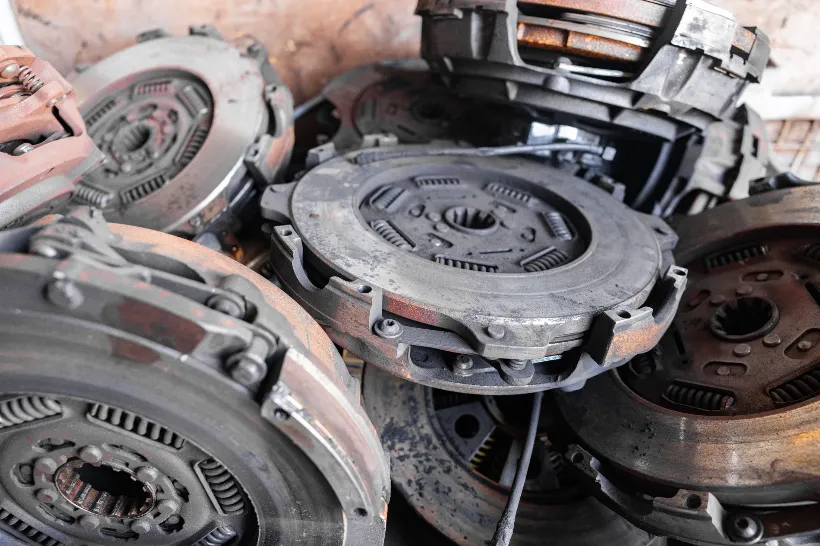5 Essential Winter Clutch Maintenance Tasks
Winter driving demands a clutch system that’s ready for the cold. This guide covers five essential maintenance tasks—from checking pedal free play to inspecting hydraulic components—that keep your clutch responsive and reliable in freezing conditions. Stay safe and operational all winter
.webp)
When the temperatures dip and roads get slick in Fontana, clutch maintenance is essential. Cold weather puts every component under stress, and if your clutch fails out there, you’re losing time, money, and potentially risking safety. Whether you're hauling over Cajon Pass or idling through the I-10 shuffle, your clutch system needs to be winter-ready.
Let’s break down five essential winter clutch maintenance tasks that'll help keep you rolling strong when the mercury drops.
1. Inspect and Adjust the Clutch Pedal Free Play
When temperatures fall, metal contracts, including your clutch linkage. This subtle shift can compromise your pedal's free play, leading to excessive wear on the clutch disc or throw-out bearing. If your pedal feels too stiff or too soft, it's time for an inspection.
Look for:
- Excessive travel or minimal resistance
- Difficulty getting into gear when cold
- Grinding noises when shifting
In manual transmission trucks, free play should typically sit between 1 and 2 inches. Too tight, and your clutch could be riding; too loose, and it might not disengage properly, both of which are a recipe for premature failure.
2. Lubricate Clutch Linkage and Release Bearings
Winter’s moisture, grit, and grime corrode your undercarriage; they also gum up your clutch linkage. If you’re dealing with a manual system, every moving part—from the pedal pivot to the cross shaft—needs to move freely. The same applies to your release bearing (aka the throw-out bearing).
A dry or sticky bearing that squeals can wear out your pressure plate and can even cause shifting delays.
Apply a winter-grade grease that won’t stiffen in freezing conditions. Focus on:
- Cross shaft bushings
- Zerk fittings (if equipped)
- Release fork pivot points
Your clutch works overtime in traffic and snow. Don’t let dry joints and frozen pivots put you on the side of the road.
3. Check Hydraulic Clutch Systems for Leaks and Moisture
If your rig runs a hydraulic clutch system, cold temperatures can cause leaks and moisture contamination to occur. Water in the system can freeze, expand, and cause internal seals to fail. And you definitely don’t want to be nursing a slave cylinder issue when you're trying to inch up a slippery grade.
What to do:
- Inspect the master and slave cylinders for signs of fluid loss or dampness around the boots
- Flush and replace the fluid with manufacturer-recommended hydraulic fluid, ideally before the first frost
- Bleed the system to remove trapped air or water
Hydraulics are precise. One bubble or ice crystal can make all the difference when shifting gets real.
4. Inspect the Clutch Disc and Pressure Plate (If Accessible)
Okay, this one’s not a weekly task, but if you’ve got the transmission out for a service or you're hearing the tell-tale signs (chatter, slipping, vibration), don’t skip a peek at your clutch disc and pressure plate.
Look for:
- Burn marks or glazing on the friction surface
- Worn, uneven clutch facings
- Hot spots on the pressure plate
Cold weather tends to amplify issues that were “borderline” in summer. A worn disc might hang on in warm months, but it will start slipping like crazy once the flywheel surface gets frosty and damp.
5. Test for Clutch Drag or Slippage Under Load
Winter roads demand precision, especially when you’re towing a full load or navigating icy slopes. One way to test your clutch’s integrity? Perform a basic slippage test:
- Engage a high gear (4th or 5th)
- Apply the parking brake
- Slowly release the clutch while applying throttle
If the engine revs without stalling, you’ve got clutch slippage, a sure sign your disc is worn, your pressure plate is weak, or your flywheel is glazed. Catch this now, and you’ll avoid a mid-mountain failure when it's 28°F and climbing isn't optional.
Don’t Overlook the Bigger Picture
The clutch doesn’t operate in a vacuum. It works in tandem with your transmission, driveline, and even your engine mounts. Winter maintenance should be holistic. Check fluids, inspect mounts, and ensure your transmission cooler is functioning properly to avoid heat spikes caused by shifting struggles in cold weather.
Final Thoughts
There’s no shortcut when it comes to clutch maintenance in winter. It’s hands-on, it’s gritty, and it’s necessary for a reliable ride through the cold season. From pedal play to pressure plates, every component plays its part in keeping you safe, efficient, and moving forward.
Cold weather doesn’t wait, and neither should you. Schedule your winter clutch inspection and maintenance today with our team at On-site Truck and Equipment Repair. Let’s keep your fleet working hard—rain, sleet, or snow.
More Articles
Contact Us
Need roadside assistance, have questions, or want to schedule your truck or trailer in for a service or repair? Get in touch, we're open Monday through Friday from 7:00am to 4:00pm.

.webp)

